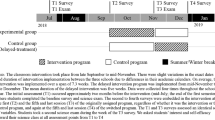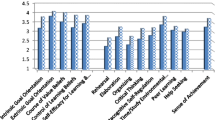Abstract
This study examines middle school students’ learning and motivation as they engaged in a new media enriched problem-based learning (PBL) environment for middle school science. Using a mixed-method design with both quantitative and qualitative data, we investigated the effect of a new media environment on sixth graders’ science learning, their motivation, and the relationship between students’ motivation and their science learning. The analysis of the results showed that: Students significantly increased their science knowledge from pretest to posttest after using the PBL program, they were motivated and enjoyed the experience, and a significant positive relationship was found between students’ motivation scores and their science knowledge posttest scores. Findings were discussed within the research framework.




Similar content being viewed by others

References
Ames, C. A. (1990). Motivation: What teachers need to know. Teachers College Record, 90(3), 409–421.
Bandura, A. (1986). Social foundations of thought and action: A social cognitive theory. Englewood Cliffs, NJ: Prentice-Hall, Inc.
Barab, S., Thomas, M., Dodge, T., Carteaux, R., & Tuzun, H. (2005). Making learning fun: Quest Atlantis, a game without guns. Educational Technology Research and Development, 53(1), 86–107.
Berlyne, D. E. (1978). Curiosity and learning. Motivation and Emotion, 2(2), 97–175.
Brookover, W. B., Thomas, S., & Paterson, A. (1964). Self-concept of ability and school achievement. Sociology of Education, 37(3), 271–278.
Carrington, V. (2004). Texts and literacies of the Shi Jinrui. British Journal of Sociology of Education, 25(2), 215–228.
Charmaz, K. (2006). Constructing grounded theory: A practical guide through qualitative analysis. Introducing qualitative methods. London: Sage Publications.
Cordova, D. I., & Lepper, M. R. (1996). Intrinsic motivation and the process of learning: Beneficial effects of contextualization, personalization, and choice. Journal of Educational Psychology, 88(4), 715–730.
Creswell, J. W. (2009). Research design: Qualitative, quantitative, and mixed methods approaches. Thousand Oaks, CA: Sage Publications.
Deci, E. L., Eghrari, H., Patrick, B. C., & Leone, D. (1994). Facilitating internalization: The self-determination theory perspective. Journal of Personality, 62, 119–142.
Dudfield, A. (1999). Literacy and cyberculture. Delaware: International Reading Association, Newark, DE.
Eccles, J. S., & Wigfield, A. (2002). Motivational beliefs, values, and goals. Annual Review of Psychology, 53(1), 109–132.
Graham, S., & Weiner, B. (1996). Theories and principles of motivation. In D. Berliner & R. Calfee (Eds.), Handbook of educational psychology (pp. 63–84). New York: Simon & Schuster Macmillan.
Harter, S. (1992). The relationship between perceived competence, affect and motivational orientation within the classroom: Processes and patterns of change. In A. K. Boggiano & T. S. Pittman (Eds.), Achievement and motivation: A social-developmental perspective (pp. 77–114). Cambridge: Cambridge University Press.
Hidi, S., & Harackiewicz, J. M. (2000). Motivating the academically unmotivated: A critical issue for the 21st century. Review of Educational Research, 70(2), 151–179.
Hoffman, B., & Nadelson, L. (2010). Motivational engagement and video gaming: A mixed methods study. Educational Technology Research and Development, 58(3), 245–270.
Judson, E. (2010). Improving technology literacy: Does it open doors to traditional content? Educational Technology Research and Development, 58(3), 271–284.
Kadijevich, D. (2000). Gender differences in computer attitude among ninth-grade students. Journal of Educational Computing Research, 22(2), 145–154.
Ketelhut, J. D. (2007). The impact of student self-efficacy on scientific inquiry skills: An exploratory investigation in River City, a multi-user virtual environment. Journal of Science Education and Technology, 16(1), 99–111.
Lane, J., & Lane, A. M. (2001). Self-efficacy and academic performance. Social Behavior and Personality, 29, 687–694.
Lepper, M. R., Iyengar, S. S., & Corpus, J. H. (2005). Intrinsic and extrinsic motivational orientations in the classroom: Age differences and academic correlates. Journal of Educational Psychology, 97(2), 184–196.
Lepper, M. R., & Malone, T. W. (1987). Intrinsic motivation and instructional effectiveness in computer-based education. In R. E. Snow & M. J. Farr (Eds.), Aptitude, learning and instruction: Cognitive and affective process analysis (Vol. 3, pp. 255–287). Hillsdale, NJ: Lawrence Erlbaum Associates.
Liu, M., & Bera, S. (2005). An analysis of cognitive tool use patterns in a hypermedia learning environment. Educational Technology Research and Development, 53(1), 5–21.
Liu, M., Bera, S., Corliss, S., Svinicki, M., & Beth, A. (2004). Understanding the connection between cognitive tool use and cognitive processes as used by sixth graders in a problem-based hypermedia learning environment. Journal of Educational Computing Research, 31(3), 309–334.
Liu, M., Hsieh, P., Cho, Y. J., & Schallert, D. L. (2006). Middle school students’ self-efficacy, attitudes, and achievement in a computer-enhanced problem-based learning environment. Journal of Interactive Learning Research, 17(3), 225–242.
Liu, M., Toprac, P., & Yuen, T. (2009). What factors make a multimedia learning environment engaging: A case study. In R. Zheng (Ed.), Cognitive effects of multimedia learning (pp. 173–192). Hershey, PA: Idea Group Inc.
Liu, M., Williams, D., & Pedersen, S. (2002). Alien Rescue: A problem-based hypermedia learning environment for middle school science. Journal of Educational Technology Systems, 30, 255–270.
Malone, T. W. (1981). Toward a theory of intrinsically motivating instruction. Cognitive Science, 4, 333–369.
McAuley, E., Duncan, T., & Tammen, V. V. (1987). Psychometric properties of the intrinsic motivation inventory in a competitive sport setting: A confirmatory factor analysis. Research Quarterly for Exercise and Sport, 60, 48–58.
Miles, M. B., & Huberman, A. M. (1994). Qualitative data analysis (2nd ed.). Thousand Oaks, CA: Sage Publications.
Mitra, A., LaFrance, B., & McCullough, S. (2001a). Differences in attitudes between women and men toward computerization. Journal of Educational Computing Research, 25(3), 227–244.
Mitra, A., Lenzmeier, S., Steffensmeier, T., Avon, R., Qu, N., & Hazen, M. (2001b). Gender and computer use in an academic institution: Report from a longitudinal study. Journal of Educational Computing Research, 23(1), 67–84.
Osborne, J., Simon, S., & Collins, S. (2003). Attitudes towards science: A review of the literature and its implication. International Journal of Science Education, 25(9), 1049–1079.
Pajares, F., & Miller, M. D. (1994). The role of self-efficacy and self-concept beliefs in mathematical problem-solving: A path analysis. Journal of Educational Psychology, 86, 193–203.
Pintrich, P., & Schunk, D. H. (2002). Motivation in education: Theory, research, and applications (2nd ed.). Upper Saddle River, NJ: Prentice Hall.
Ryan, R. M., Connell, J. P., & Plant, R. W. (1990). Emotions in non-directed text learning. Learning and Individual Differences, 2, 1–17.
Ryan, R. M., & Deci, E. L. (2000). Self-determination theory and the facilitation of intrinsic motivation, social development, and well-being. American Psychologist, 55(1), 68–78.
Ryan, R. M., Koestner, R., & Deci, E. L. (1991). Varied forms of persistence: When free-choice behavior is not intrinsically motivated. Motivation and Emotion, 15, 185–205.
Ryan, R., Rigby, C., & Przybylski, A. (2006). The motivational pull of video games: A self-determination theory approach. Motivation and Emotion, 30(4), 344–360.
Shernoff, D. J., Csikszentmihalyi, M., Schneider, B., & Shernoff, E. S. (2003). Student engagement in high school classrooms from the perspective of flow theory. School Psychology Quarterly, 18(2), 158–176.
Stake, J. E., & Mares, K. R. (2001). Science enrichment programs for gifted high school girls and boys: Predictors of program impact on science confidence and motivation. Journal of Research in Science Teaching, 38(10), 1065–1088.
Stipek, D. (1993). Motivation to learn: From theory to practice. Needham Heights, MA: Allyn & Bacon.
Strauss, A. L., & Corbin, J. M. (1998). Basics of qualitative research: Techniques and procedures for developing. Thousand Oaks, CA: Sage Publications Inc.
Toprac, P. (2011). Motivating by design: Using digital-game based learning techniques to create an interesting problem-based learning environment. In P. Felicia (Ed.), Handbook of research on improving learning and motivation through educational games: Multidisciplinary approaches. Hershey, PA: IGI Global.
White, R. W. (1959). Motivation reconsidered: The concept of competence. Psychological Review, 66(5), 297–333.
Author information
Authors and Affiliations
Corresponding author
Additional information
Second through fourth authors are listed in an alphabetical order.
Rights and permissions
About this article
Cite this article
Liu, M., Horton, L., Olmanson, J. et al. A study of learning and motivation in a new media enriched environment for middle school science. Education Tech Research Dev 59, 249–265 (2011). https://doi.org/10.1007/s11423-011-9192-7
Published:
Issue Date:
DOI: https://doi.org/10.1007/s11423-011-9192-7



